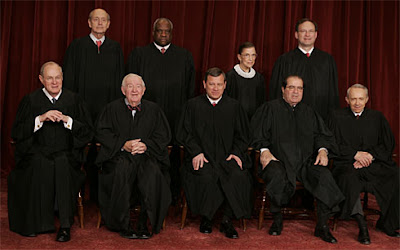
Image provided by NCinDC on flickr
The United States Constitution established the three branches of our federal government. If you follow the news at all, you can't help reading or watching stories about the two most visible branches, the executive branch, and the legislative branch. The front pages are filled with articles on what the president did or said. The mass media have made superstars of so many congressmen that you need only refer to them by their last names. Names such as Pelosi, Kennedy, Specter, Reid, and McConnell are heard so often that even a news addict gets tired of reading about them.
As a senior in high school my U. S. Government teacher introduced us to that third unknown branch of our government called the Judiciary branch. Of course we had all heard of this branch, but like the rest of the country none of us knew much about the United States Supreme Court. The media didn’t give it much coverage, so the Judiciary branch somehow lost it’s power in the public eye. The Founding Fathers of the United States, however, never lost sight of the fact that too much power in too few hands tends to lead to an abuse of that power. They created the three branches of our government, with enough checks and balances built into the constitution, that no one branch could do much without the backing of at least one of the other two.
So it was then, in my senior year in high school, that my secret fascination with the Supreme Court began. I started looking deeper into the newspaper than the front pages, for rulings the Supreme Court had made. I began to notice that you could always count on certain Justices to vote a certain way on any given issue. I began to play a game where I would predict how each member of the Supreme Court would vote on such issues as abortion, affirmative action, pro business issues, and pro union issues. I soon realized that I could name all nine Supreme Court Justices just by breaking down the way the Court rules on the major issues. The Court has it’s left wing, right wing, and swing voters. The current Justices of the Court can be broken down in the following way:
Left Wing | Swing Vote | Right Wing |
John Paul Stevens | Anthony M. Kennedy | Chief Justice John Roberts |
David H. Souter | Antonin Scalia | |
Ruth Bader Ginsburg | Clarence Thomas | |
Stephen Breyer | Samuel Alito |
Kennedy, Breyer, Stevens, Thomas, Roberts, Ginsburg, Scalia, Alito, and Souter
As you can see, the Supreme Court is, at the moment, balanced with four consistent votes on the left and four consistent votes on the right. Justice Kennedy has been the deciding vote on so many issues that one might say that Justice Kennedy is the Court's most important member. Every now and then one of the Justices will vote in an unexpected way. When this happens, I like to read that Justice's opinion on the issue to find out why he or she voted that way. It's a way of getting to know the Justice a little better and it's a reassuring comfort to know the Justices do give much thought to each vote.
One last ironic fact, that I find most interesting, is that 7 of the 9 Justices were appointed by Republican presidents. (Ginsburg and Breyer were both Clinton appointees) Justices Souter, Stevens, and Kennedy all drifted to the left, philosophically speaking, after they had been seated. Interesting indeed.

No comments:
Post a Comment